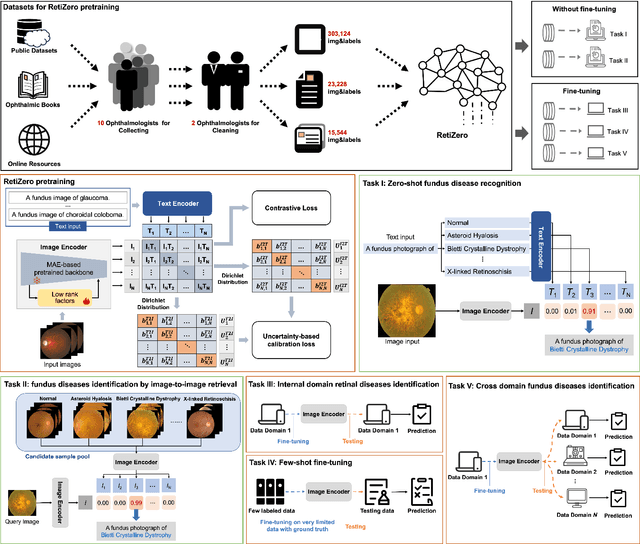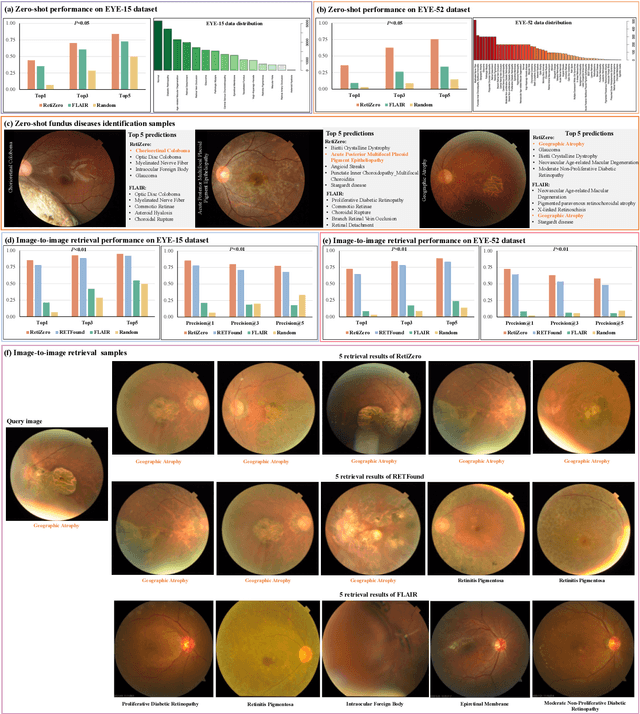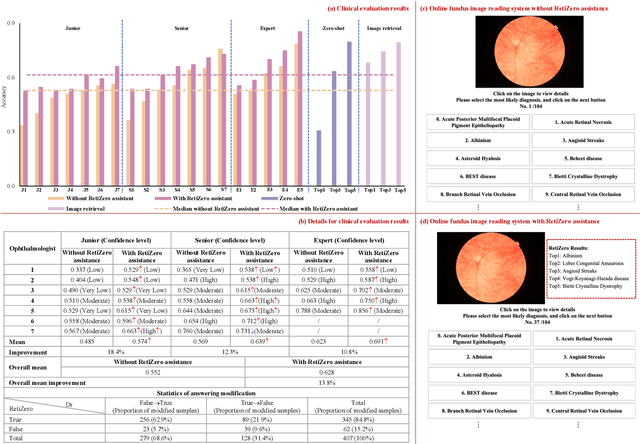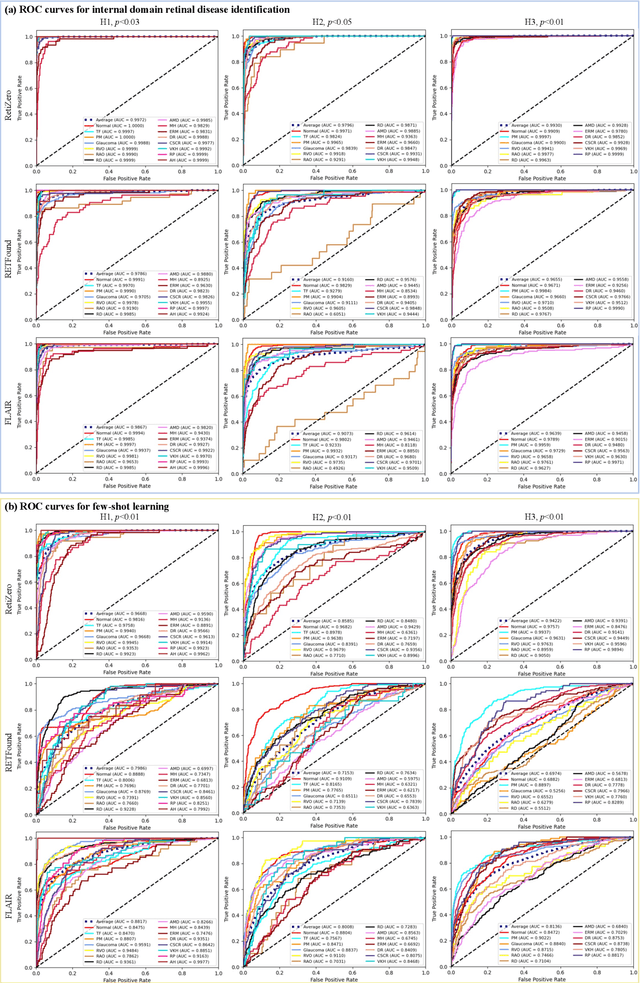Yanda Meng
Incomplete Modality Disentangled Representation for Ophthalmic Disease Grading and Diagnosis
Feb 17, 2025Abstract:Ophthalmologists typically require multimodal data sources to improve diagnostic accuracy in clinical decisions. However, due to medical device shortages, low-quality data and data privacy concerns, missing data modalities are common in real-world scenarios. Existing deep learning methods tend to address it by learning an implicit latent subspace representation for different modality combinations. We identify two significant limitations of these methods: (1) implicit representation constraints that hinder the model's ability to capture modality-specific information and (2) modality heterogeneity, causing distribution gaps and redundancy in feature representations. To address these, we propose an Incomplete Modality Disentangled Representation (IMDR) strategy, which disentangles features into explicit independent modal-common and modal-specific features by guidance of mutual information, distilling informative knowledge and enabling it to reconstruct valuable missing semantics and produce robust multimodal representations. Furthermore, we introduce a joint proxy learning module that assists IMDR in eliminating intra-modality redundancy by exploiting the extracted proxies from each class. Experiments on four ophthalmology multimodal datasets demonstrate that the proposed IMDR outperforms the state-of-the-art methods significantly.
* 7 Pages, 6 figures
Self-adaptive vision-language model for 3D segmentation of pulmonary artery and vein
Jan 07, 2025Abstract:Accurate segmentation of pulmonary structures iscrucial in clinical diagnosis, disease study, and treatment planning. Significant progress has been made in deep learning-based segmentation techniques, but most require much labeled data for training. Consequently, developing precise segmentation methods that demand fewer labeled datasets is paramount in medical image analysis. The emergence of pre-trained vision-language foundation models, such as CLIP, recently opened the door for universal computer vision tasks. Exploiting the generalization ability of these pre-trained foundation models on downstream tasks, such as segmentation, leads to unexpected performance with a relatively small amount of labeled data. However, exploring these models for pulmonary artery-vein segmentation is still limited. This paper proposes a novel framework called Language-guided self-adaptive Cross-Attention Fusion Framework. Our method adopts pre-trained CLIP as a strong feature extractor for generating the segmentation of 3D CT scans, while adaptively aggregating the cross-modality of text and image representations. We propose a s pecially designed adapter module to fine-tune pre-trained CLIP with a self-adaptive learning strategy to effectively fuse the two modalities of embeddings. We extensively validate our method on a local dataset, which is the largest pulmonary artery-vein CT dataset to date and consists of 718 labeled data in total. The experiments show that our method outperformed other state-of-the-art methods by a large margin. Our data and code will be made publicly available upon acceptance.
CathAction: A Benchmark for Endovascular Intervention Understanding
Aug 23, 2024Abstract:Real-time visual feedback from catheterization analysis is crucial for enhancing surgical safety and efficiency during endovascular interventions. However, existing datasets are often limited to specific tasks, small scale, and lack the comprehensive annotations necessary for broader endovascular intervention understanding. To tackle these limitations, we introduce CathAction, a large-scale dataset for catheterization understanding. Our CathAction dataset encompasses approximately 500,000 annotated frames for catheterization action understanding and collision detection, and 25,000 ground truth masks for catheter and guidewire segmentation. For each task, we benchmark recent related works in the field. We further discuss the challenges of endovascular intentions compared to traditional computer vision tasks and point out open research questions. We hope that CathAction will facilitate the development of endovascular intervention understanding methods that can be applied to real-world applications. The dataset is available at https://airvlab.github.io/cathdata/.
Uncertainty is Fragile: Manipulating Uncertainty in Large Language Models
Jul 15, 2024



Abstract:Large Language Models (LLMs) are employed across various high-stakes domains, where the reliability of their outputs is crucial. One commonly used method to assess the reliability of LLMs' responses is uncertainty estimation, which gauges the likelihood of their answers being correct. While many studies focus on improving the accuracy of uncertainty estimations for LLMs, our research investigates the fragility of uncertainty estimation and explores potential attacks. We demonstrate that an attacker can embed a backdoor in LLMs, which, when activated by a specific trigger in the input, manipulates the model's uncertainty without affecting the final output. Specifically, the proposed backdoor attack method can alter an LLM's output probability distribution, causing the probability distribution to converge towards an attacker-predefined distribution while ensuring that the top-1 prediction remains unchanged. Our experimental results demonstrate that this attack effectively undermines the model's self-evaluation reliability in multiple-choice questions. For instance, we achieved a 100 attack success rate (ASR) across three different triggering strategies in four models. Further, we investigate whether this manipulation generalizes across different prompts and domains. This work highlights a significant threat to the reliability of LLMs and underscores the need for future defenses against such attacks. The code is available at https://github.com/qcznlp/uncertainty_attack.
CLIP-DR: Textual Knowledge-Guided Diabetic Retinopathy Grading with Ranking-aware Prompting
Jul 04, 2024Abstract:Diabetic retinopathy (DR) is a complication of diabetes and usually takes decades to reach sight-threatening levels. Accurate and robust detection of DR severity is critical for the timely management and treatment of diabetes. However, most current DR grading methods suffer from insufficient robustness to data variability (\textit{e.g.} colour fundus images), posing a significant difficulty for accurate and robust grading. In this work, we propose a novel DR grading framework CLIP-DR based on three observations: 1) Recent pre-trained visual language models, such as CLIP, showcase a notable capacity for generalisation across various downstream tasks, serving as effective baseline models. 2) The grading of image-text pairs for DR often adheres to a discernible natural sequence, yet most existing DR grading methods have primarily overlooked this aspect. 3) A long-tailed distribution among DR severity levels complicates the grading process. This work proposes a novel ranking-aware prompting strategy to help the CLIP model exploit the ordinal information. Specifically, we sequentially design learnable prompts between neighbouring text-image pairs in two different ranking directions. Additionally, we introduce a Similarity Matrix Smooth module into the structure of CLIP to balance the class distribution. Finally, we perform extensive comparisons with several state-of-the-art methods on the GDRBench benchmark, demonstrating our CLIP-DR's robustness and superior performance. The implementation code is available \footnote{\url{https://github.com/Qinkaiyu/CLIP-DR}
Common and Rare Fundus Diseases Identification Using Vision-Language Foundation Model with Knowledge of Over 400 Diseases
Jun 13, 2024



Abstract:The current retinal artificial intelligence models were trained using data with a limited category of diseases and limited knowledge. In this paper, we present a retinal vision-language foundation model (RetiZero) with knowledge of over 400 fundus diseases. Specifically, we collected 341,896 fundus images paired with text descriptions from 29 publicly available datasets, 180 ophthalmic books, and online resources, encompassing over 400 fundus diseases across multiple countries and ethnicities. RetiZero achieved outstanding performance across various downstream tasks, including zero-shot retinal disease recognition, image-to-image retrieval, internal domain and cross-domain retinal disease classification, and few-shot fine-tuning. Specially, in the zero-shot scenario, RetiZero achieved a Top5 score of 0.8430 and 0.7561 on 15 and 52 fundus diseases respectively. In the image-retrieval task, RetiZero achieved a Top5 score of 0.9500 and 0.8860 on 15 and 52 retinal diseases respectively. Furthermore, clinical evaluations by ophthalmology experts from different countries demonstrate that RetiZero can achieve performance comparable to experienced ophthalmologists using zero-shot and image retrieval methods without requiring model retraining. These capabilities of retinal disease identification strengthen our RetiZero foundation model in clinical implementation.
Exploring Concept Depth: How Large Language Models Acquire Knowledge at Different Layers?
Apr 10, 2024Abstract:This paper studies the phenomenon that different concepts are learned in different layers of large language models, i.e. more difficult concepts are fully acquired with deeper layers. We define the difficulty of concepts by the level of abstraction, and here it is crudely categorized by factual, emotional, and inferential. Each category contains a spectrum of tasks, arranged from simple to complex. For example, within the factual dimension, tasks range from lie detection to categorizing mathematical problems. We employ a probing technique to extract representations from different layers of the model and apply these to classification tasks. Our findings reveal that models tend to efficiently classify simpler tasks, indicating that these concepts are learned in shallower layers. Conversely, more complex tasks may only be discernible at deeper layers, if at all. This paper explores the implications of these findings for our understanding of model learning processes and internal representations. Our implementation is available at \url{https://github.com/Luckfort/CD}.
Health-LLM: Personalized Retrieval-Augmented Disease Prediction Model
Feb 08, 2024Abstract:Artificial intelligence (AI) in healthcare has significantly advanced intelligent medical treatment. However, traditional intelligent healthcare is limited by static data and unified standards, preventing full integration with individual situations and other challenges. Hence, a more professional and detailed intelligent healthcare method is needed for development. To this end, we propose an innovative framework named Heath-LLM, which combines large-scale feature extraction and medical knowledge trade-off scoring. Compared to traditional health management methods, our approach has three main advantages. First, our method integrates health reports into a large model to provide detailed task information. Second, professional medical expertise is used to adjust the weighted scores of health characteristics. Third, we use a semi-automated feature extraction framework to enhance the analytical power of language models and incorporate expert insights to improve the accuracy of disease prediction. We have conducted disease prediction experiments on a large number of health reports to assess the effectiveness of Health-LLM. The results of the experiments indicate that the proposed method surpasses traditional methods and has the potential to revolutionize disease prediction and personalized health management. The code is available at https://github.com/jmyissb/HealthLLM.
The Impact of Reasoning Step Length on Large Language Models
Jan 20, 2024Abstract:Chain of Thought (CoT) is significant in improving the reasoning abilities of large language models (LLMs). However, the correlation between the effectiveness of CoT and the length of reasoning steps in prompts remains largely unknown. To shed light on this, we have conducted several empirical experiments to explore the relations. Specifically, we design experiments that expand and compress the rationale reasoning steps within CoT demonstrations, while keeping all other factors constant. We have the following key findings. First, the results indicate that lengthening the reasoning steps in prompts, even without adding new information into the prompt, considerably enhances LLMs' reasoning abilities across multiple datasets. Alternatively, shortening the reasoning steps, even while preserving the key information, significantly diminishes the reasoning abilities of models. This finding highlights the importance of the number of steps in CoT prompts and provides practical guidance to make better use of LLMs' potential in complex problem-solving scenarios. Second, we also investigated the relationship between the performance of CoT and the rationales used in demonstrations. Surprisingly, the result shows that even incorrect rationales can yield favorable outcomes if they maintain the requisite length of inference. Third, we observed that the advantages of increasing reasoning steps are task-dependent: simpler tasks require fewer steps, whereas complex tasks gain significantly from longer inference sequences.
Automatically Segment the Left Atrium and Scars from LGE-MRIs Using a Boundary-focused nnU-Net
Apr 27, 2023Abstract:Atrial fibrillation (AF) is the most common cardiac arrhythmia. Accurate segmentation of the left atrial (LA) and LA scars can provide valuable information to predict treatment outcomes in AF. In this paper, we proposed to automatically segment LA cavity and quantify LA scars with late gadolinium enhancement Magnetic Resonance Imagings (LGE-MRIs). We adopted nnU-Net as the baseline model and exploited the importance of LA boundary characteristics with the TopK loss as the loss function. Specifically, a focus on LA boundary pixels is achieved during training, which provides a more accurate boundary prediction. On the other hand, a distance map transformation of the predicted LA boundary is regarded as an additional input for the LA scar prediction, which provides marginal constraint on scar locations. We further designed a novel uncertainty-aware module (UAM) to produce better results for predictions with high uncertainty. Experiments on the LAScarQS 2022 dataset demonstrated our model's superior performance on the LA cavity and LA scar segmentation. Specifically, we achieved 88.98\% and 64.08\% Dice coefficient for LA cavity and scar segmentation, respectively. We will make our implementation code public available at https://github.com/level6626/Boundary-focused-nnU-Net.
 Add to Chrome
Add to Chrome Add to Firefox
Add to Firefox Add to Edge
Add to Edge